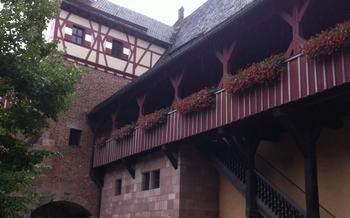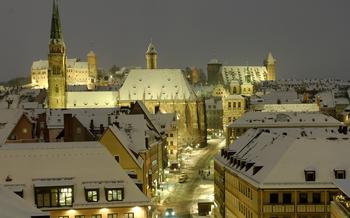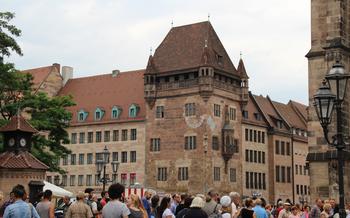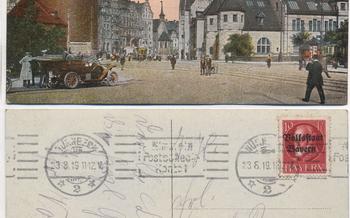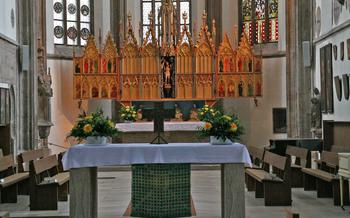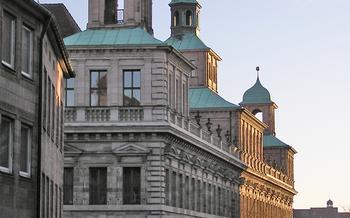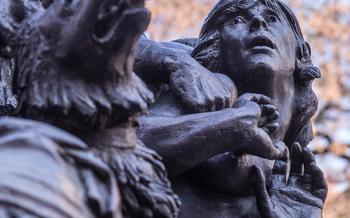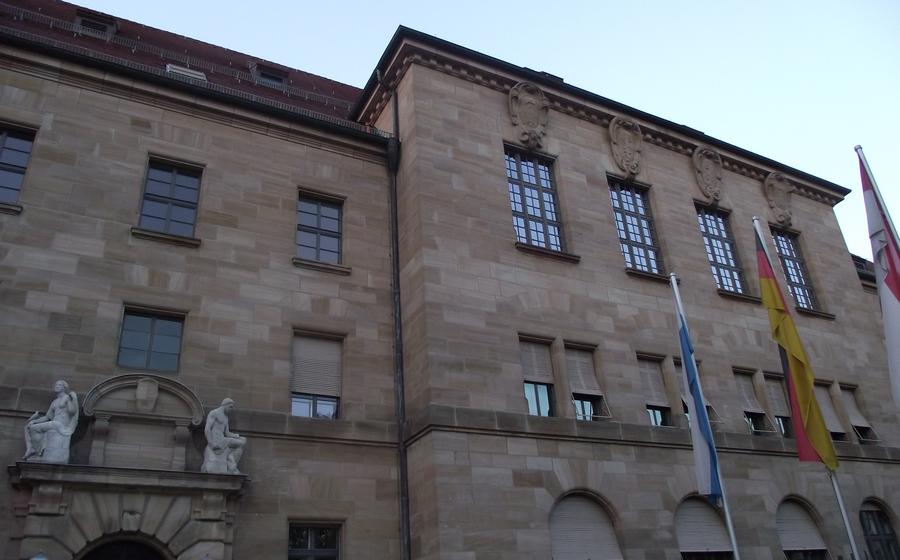
Nuremberg Trials Memorial (Memorium Nürnberger Prozesse)
- Memorium Nürnberger Prozesse: A Commemorative Site
- Permanent Exhibition: Trial of the Major War Criminals
- Other Trials and Proceedings
- The Nuremberg Principles: A Legacy of International Law
- Witness Testimony and Personal Accounts
- Interactive Elements and Multimedia Displays
- Guided Tours and Educational Programs
- Research and Documentation Center
- Memorial Hall: A Place of Remembrance
- Temporary Exhibitions and Special Events
- Accessibility and Visitor Information
- Location and Transportation
- Nearby Attractions and Points of Interest
- Insider Tip: Guided Tour for a Deeper Experience
Memorium Nürnberger Prozesse: A Commemorative Site
The Memorium Nürnberger Prozesse was established in 2000 as a permanent reminder of the Nuremberg Trials. This commemorative site is dedicated to preserving the memory of the trials and providing a deeper understanding of their significance. The museum's mission is to educate visitors about the atrocities committed during the Nazi regime, the legal proceedings that followed, and the impact of the trials on international law and human rights.
Through a variety of exhibitions and displays, the museum provides unique insights into the trials and their aftermath. Visitors can explore the original courtrooms where the trials were held, learn about the charges and evidence presented against the defendants, and witness the impact of the verdicts on the course of history. The museum also features personal accounts and testimonies from witnesses and survivors, providing a powerful and emotional connection to the human toll of the Nazi regime.
Permanent Exhibition: Trial of the Major War Criminals
The permanent exhibition at the Memorium Nürnberger Prozesse offers a detailed account of the trial against the 24 major war criminals, including the likes of Hermann Göring, Rudolf Hess, and Albert Speer. Visitors can delve into the charges brought against these individuals, ranging from conspiracy to wage aggressive war to crimes against humanity and war crimes. The exhibition meticulously presents the evidence presented during the trial, highlighting key moments and testimonies that shaped the course of justice.
The significance of the verdict in this trial cannot be overstated. It established the principle of individual responsibility for war crimes and crimes against humanity, overturning the traditional notion of state immunity. The trial also set a precedent for the prosecution of future war criminals, paving the way for the development of international criminal law.
Moreover, the exhibition explores the impact of the Nuremberg Trials on the development of human rights law. It highlights the adoption of the Universal Declaration of Human Rights in 1948, which was directly influenced by the principles established during the trials. This declaration laid the foundation for the protection of fundamental human rights and freedoms worldwide.
Other Trials and Proceedings
In addition to the Trial of the Major War Criminals, several subsequent trials were held in Nuremberg, collectively known as the Subsequent Nuremberg Trials. These trials focused on specific organizations, groups, and individuals accused of war crimes, crimes against humanity, and other atrocities committed during the Nazi regime.
The most notable of these trials were the Doctors' Trial, which addressed the role of medical personnel in Nazi human experimentation and forced sterilization; the Judges' Trial, which examined the complicity of German judges and lawyers in the Nazi legal system; and the Einsatzgruppen Trial, which investigated the activities of mobile killing units responsible for mass murder in Eastern Europe.
These trials played a crucial role in establishing the principle of individual responsibility for war crimes and crimes against humanity. They also contributed to the development of international law, particularly in the areas of human rights and the prevention of genocide.
The lessons learned from the Nuremberg Trials and the subsequent proceedings continue to be relevant today, as the world continues to grapple with issues of war crimes, genocide, and the protection of human rights.
The Nuremberg Principles: A Legacy of International Law
The Nuremberg Trials not only brought the perpetrators of heinous crimes to justice but also established a set of principles that would profoundly influence international law and the development of the International Criminal Court. These principles, known as the Nuremberg Principles, laid the foundation for the prosecution of war crimes, crimes against humanity, and genocide.
One of the most significant principles established during the trials was the concept of individual responsibility. This principle held that individuals could be held accountable for their actions, even if they were acting under the orders of a superior. This principle was a departure from traditional notions of state sovereignty and immunity and helped to establish the idea that individuals could be held criminally responsible for their actions.
Another key principle established at Nuremberg was the crime of genocide. This principle defined genocide as the intentional destruction, in whole or in part, of a national, ethnical, racial, or religious group. This was the first time that genocide had been recognized as a crime under international law, and it has since become a cornerstone of international criminal law.
The Nuremberg Principles also emphasized the importance of due process and fair trial rights for those accused of war crimes and crimes against humanity. These principles ensured that the defendants in the Nuremberg Trials were given a fair hearing and that their rights were protected.
The Nuremberg Principles have had a profound impact on the development of international criminal law. They have been incorporated into the Rome Statute of the International Criminal Court, which is the treaty that established the ICC. The principles have also been used to prosecute war criminals in other international tribunals, such as the International Criminal Tribunal for the former Yugoslavia and the International Criminal Tribunal for Rwanda.
The Nuremberg Principles are a lasting legacy of the Nuremberg Trials. They have helped to establish the principles of individual responsibility, crimes against humanity, and genocide as fundamental principles of international law. These principles have played a vital role in the development of the ICC and have been used to prosecute war criminals around the world.
Witness Testimony and Personal Accounts
The Memorium Nürnberger Prozesse features powerful and moving accounts from witnesses and survivors who experienced the horrors of Nazi atrocities firsthand. These personal narratives offer a unique perspective on the trials, shedding light on the human toll of the war and the impact of the crimes committed by the Nazi regime.
Through audio recordings, video testimonies, and written statements, visitors can hear the voices of those who survived the concentration camps, witnessed the atrocities committed by the Einsatzgruppen death squads, and endured the forced labor and medical experiments conducted by the Nazis. These accounts provide a deeply personal and emotional dimension to the historical record, bringing the past to life and reminding us of the human suffering that took place during this dark chapter in history.
Listening to these firsthand accounts is a powerful experience that helps visitors to connect with the human stories behind the trials and to understand the profound impact of the Nazi regime on the lives of millions of people.
Interactive Elements and Multimedia Displays
The Memorium Nürnberger Prozesse incorporates interactive technology to engage visitors with the content and provide a more immersive experience. Multimedia presentations and documentaries offer additional context and perspectives, helping visitors gain a deeper understanding of the trials and their significance. These interactive elements include:
-
Touchscreen displays: Visitors can explore historical documents, photographs, and maps using touchscreen displays located throughout the museum. These displays provide additional information and allow visitors to delve deeper into specific topics.
-
Video testimonials: The museum features video interviews with survivors and witnesses of the Nazi atrocities. These personal accounts offer a powerful and moving glimpse into the experiences of those who were directly affected by the events of the Second World War.
-
Audio guides: Audio guides are available in multiple languages, providing visitors with detailed information about the exhibits and the history of the trials. The guides offer a personalized and self-paced tour experience.
-
Virtual reality experience: The museum offers a virtual reality experience that allows visitors to step back in time and witness the Nuremberg Trials as they unfolded. This immersive experience provides a unique perspective on the proceedings and the challenges faced by the judges and prosecutors.
Guided Tours and Educational Programs
The Memorium Nürnberger Prozesse offers guided tours led by knowledgeable museum educators who provide expert insights and historical context. These tours allow visitors to delve deeper into the significance of the Nuremberg Trials and gain a comprehensive understanding of the legal proceedings. The guides offer personalized explanations, highlighting key aspects of the trials, such as the charges against the defendants, the evidence presented, and the impact of the verdict.
Educational programs are also available for students and groups, enabling them to explore the themes of the museum in greater depth. These programs are designed to foster critical thinking and promote a deeper understanding of the past and its relevance to the present. By participating in these programs, students can engage with the material on a personal level, ask questions, and gain insights into the complexities of international law and human rights.
Research and Documentation Center
The Memorium Nürnberger Prozesse also houses an extensive Research and Documentation Center. This facility serves as a valuable resource for scholars, researchers, and anyone interested in delving deeper into the history of the Nuremberg Trials. The center contains a vast collection of documents, transcripts, and research materials related to the trials, providing a treasure trove of information for those seeking to understand this pivotal moment in history.
The center's collection includes trial transcripts, witness statements, legal briefs, and other primary sources that offer a comprehensive record of the proceedings. These documents provide researchers with the opportunity to examine the trials in detail, gaining insights into the legal arguments, evidentiary considerations, and decision-making processes that shaped the outcomes.
The Research and Documentation Center is open to the public, allowing visitors to access these valuable resources and conduct their own research. Whether you are a student, a historian, or simply someone with a keen interest in the Nuremberg Trials, this center provides a wealth of information to explore and learn from.
Memorial Hall: A Place of Remembrance
In the heart of the Memorium Nürnberger Prozesse lies the poignant Memorial Hall, a serene space dedicated to quiet reflection and contemplation. Visitors are invited to pause and remember the countless victims of Nazi atrocities, honoring their lives and acknowledging the profound suffering they endured. The hall's somber atmosphere encourages a deep sense of introspection and empathy, fostering a profound connection to the past.
The Memorial Hall serves as a powerful reminder of the horrors of war and the devastating consequences of hatred and intolerance. It is a place where visitors can pay their respects, remember the victims, and reflect on the lessons of history. By fostering a deep sense of remembrance, the Memorial Hall encourages visitors to actively work towards a future free from violence and injustice.
Temporary Exhibitions and Special Events
The Memorium Nürnberger Prozesse complements its permanent exhibitions with a diverse range of temporary exhibitions and special events. These exhibitions delve into specific aspects of the Nuremberg Trials, explore related historical topics, and showcase new perspectives and research findings. Visitors can engage with thought-provoking displays, installations, and multimedia presentations that offer fresh insights into the complexities of the trials and their aftermath.
Special events, such as conferences, lectures, and workshops, provide a platform for experts, scholars, and practitioners to discuss issues related to international law, human rights, and the legacy of the Nuremberg Trials. These events foster dialogue and exchange of ideas, encouraging a deeper understanding of the past and its relevance to contemporary challenges.
By organizing temporary exhibitions and special events, the Memorium Nürnberger Prozesse remains a vibrant and dynamic institution, continuously expanding its educational and commemorative mission. It invites visitors to explore the ongoing significance of the Nuremberg Trials and their impact on our understanding of justice, accountability, and the rule of law.
Accessibility and Visitor Information
The Memorium Nürnberger Prozesse is committed to providing a welcoming and inclusive environment for all visitors. The memorial site is wheelchair accessible, and audio guides are available in multiple languages. Visitors can also access multilingual materials and brochures to enhance their understanding of the exhibitions. Please note that admission to the museum is free of charge.
For more information on opening hours, guided tours, and educational programs, please visit the museum's official website. The website also provides detailed directions to the memorial site and information on public transportation options and parking. With its accessible features and informative resources, the Memorium Nürnberger Prozesse ensures that every visitor has a meaningful and enriching experience.
Location and Transportation
The Memorium Nürnberger Prozesse is conveniently located in the heart of Nuremberg, within easy reach of public transportation and major attractions. The closest U-Bahn (subway) station is Lorenzkirche, a short walk from the memorial site. Alternatively, visitors can take trams 4, 6, and 11 to the Justizpalast (Palace of Justice) stop. For those arriving by car, there are several parking garages nearby, including the Parkhaus Lorenzkirche and the Parkhaus am Opernhaus.
To explore the city's rich history and cultural heritage, Nuremberg offers an excellent public transportation system. The U-Bahn and tram network connects all major attractions, including the Imperial Castle, the Germanic National Museum, and the Albrecht Dürer House. Visitors can purchase single tickets, day passes, or the Nuremberg Card, which provides unlimited travel on public transportation, free admission to many museums, and discounts on various attractions.
Nearby Attractions and Points of Interest
Nuremberg is a treasure trove of history and culture, with many fascinating attractions to discover. After visiting the Memorium Nürnberger Prozesse, take some time to explore the city's other landmarks and hidden gems.
-
Nuremberg Castle: Perched on a hill overlooking the city, this imposing castle complex offers stunning views and a glimpse into Nuremberg's medieval past. Explore its fortifications, towers, and museums, and learn about its role in German history.
-
Germanisches Nationalmuseum: Delve into the rich history and culture of Germany at this renowned museum. With an extensive collection of artifacts, artworks, and exhibits, it showcases everything from prehistoric times to the present day.
-
St. Lorenz Church: This magnificent Gothic church is a symbol of Nuremberg's architectural heritage. Admire its intricate stained glass windows, impressive sculptures, and the famous "Männleinlaufen" clock with its moving figures.
-
Hauptmarkt: The heart of Nuremberg, this lively square is surrounded by colorful buildings, historic fountains, and bustling markets. Take a stroll, soak up the atmosphere, and sample some local delicacies at one of the many restaurants or cafes.
-
Albrecht Dürer House: Step into the world of one of Germany's most celebrated artists at his former home and studio. Explore his works, learn about his life, and discover the creative spirit that shaped Nuremberg's artistic landscape.
These are just a few of the many attractions Nuremberg has to offer. Whether you're interested in history, art, architecture, or simply soaking up the local atmosphere, you'll find something to captivate you in this vibrant city.
Insider Tip: Guided Tour for a Deeper Experience
To fully immerse yourself in the history and significance of the Memorium Nürnberger Prozesse, consider booking a guided tour. Led by knowledgeable museum educators, these tours provide expert insights into the historical context, legal proceedings, and lasting impact of the Nuremberg Trials.
Your guide will take you through the various exhibits, explaining the charges against the defendants, the evidence presented, and the significance of the verdicts. They will also share personal anecdotes and stories from the trials, bringing the events to life and helping you understand the human toll of the atrocities committed during World War II.
By participating in a guided tour, you'll gain a deeper appreciation for the importance of the Nuremberg Trials and their role in shaping international law and human rights. It's an enriching experience that will leave you with a lasting understanding of this pivotal moment in history.
